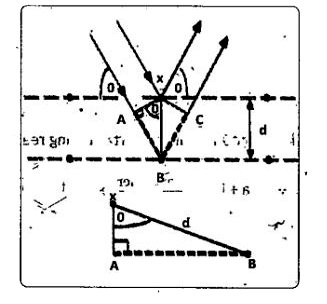Derive Bragg's equation . Solution in Telugu
When a beam of X-rays strikes a crystal, the constituent particles of the crystal scatter or deflect some of the X-rays from their original path. The scattered X- ray.s can be detected on a photographic.plate. From the diffraction pattern, the distance between constituent particles in a crystal can be studied.

In the above figure X -rays with wavelength λ strike a crystal face at an angle θ and then reflect at the same angle. The rays that strike an atom in the second layer are diffracted at the same angle θ but because the second layer of atoms away from the X-ray source, the distance that the X-rays has to travel is more. to reach the second layer. The path difference.is indicated by AB in the figure, AB is equal to the distance between atomic layers d(=zB) times the sine of the angle θ
sinθ=ABd,SoAB=dsinθ
The X- rays have to travel a total extra distance AB +BC.
AB+BC=2dsinθ(∴AB=BC)
The different X-rays striking the two layers of atoms are in - phase initially and also they will be in - phase after reflection only the extra distance AB + BC is equal to a whole number of wavelengths nλ where n is an integer (1, 2, 3, 4....)
∴AB+B=2dsinθ=nλ
This is known as Bragg.s equation.
By knowing the value of ϕ,λ the value of θ can be measured, and the value of n is a small.integer, usually 1. Thus the distanced between layers of atoms in a crystal can be calculated
Topper's Solved these Questions
- MODEL PAPER 10BOOK - VGS PUBLICATION-BRILLIANTCHAPTER - MODEL PAPER 10EXERCISE - SECTION-C
10 Videos
- MODEL PAPER 10BOOK - VGS PUBLICATION-BRILLIANTCHAPTER - MODEL PAPER 10EXERCISE - SECTION-C
10 Videos
- MODEL PAPER 1 BOOK - VGS PUBLICATION-BRILLIANTCHAPTER - MODEL PAPER 1 EXERCISE - SECTION-C
9 Videos
- MODEL PAPER 12BOOK - VGS PUBLICATION-BRILLIANTCHAPTER - MODEL PAPER 12EXERCISE - Section - C
9 Videos
Similar Questions
State and explain Kohlrausch's law of indendent migration of ions.
View SolutionState and explain Kohlrausch's law of indendent migration of ions.
View SolutionState and explain Kohlrausch's law of indendent migration of ions.
View SolutionGive a detailed account of the Collision theory of reaction rates of biomolecular reaction.
View SolutionBRAGG'S EQUATION
View SolutionWhich of the following is Bragg's equation ?
View SolutionBragg's law is given by the equation:
View SolutionDerive Bragg's equation .
View SolutionBragg's equation for diffraction is
View SolutionThe solution of Bragg's equation will not exist if
View SolutionThe Bragg's equation is "________________"
View SolutionThe solution of Bragg's equation is possible if :
View SolutionWhat is Bragg's equation ?
View SolutionDerive the Bragg's equation useful for X-ray diffraction of crystals.
View SolutionBragg's Equation
View SolutionBragg's equation is:
View Solution
